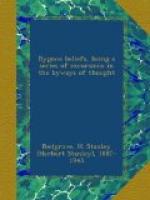[3] Ibid., p. 71.
All this seems to me very strongly to support my view of the origin of alchemy, which requires a specifically Christian mysticism only for this specific concept of the Philosopher’s Stone in its fully-fledged form. At any rate, the development of alchemical doctrine can be seen to have proceeded concomitantly with the development of mystical philosophy and theology. Those who are not prepared here to see effect and cause may be asked not only to formulate some other hypothesis in explanation of the origin of alchemy, but also to explain this fact of concomitant development.
From the standpoint of the transcendental theory of alchemy it has been urged “that the language of mystical theology seemed to be hardly so suitable to the exposition [as I maintain] or concealment of chemical theories, as the language of a definite and generally credited branch of science was suited to the expression of a veiled and symbolical process such as the regeneration of man."[1] But such a statement is only possible with respect to the latest days of alchemy, when there WAS a science of chemistry, definite and generally credited. The science of chemistry, it must be remembered, had no growth separate from alchemy, but evolved therefrom. Of the days before this evolution had been accomplished, it would be in closer accord with the facts to say that theology, including the doctrine of man’s regeneration, was in the position of “a definite and generally credited branch of science,” whereas chemical phenomena were veiled in deepest mystery and tinged with the dangers appertaining to magic. As concerns the origin of alchemy, therefore, the argument as to suitability of language appears to support my own theory; it being open to assume that after formulation—that is, in alchemy’s latter days—chemical nomenclature and theories were employed by certain writers to veil heterodox religious doctrine.
[1] PHILIP S. WELLBY, M.A., in The Journal of the Alchemical Society, vol. ii. (1914), p. 104.
Another recent writer on the subject, my friend the late Mr ABDUL-ALI, has remarked that “he thought that, in the mind of the alchemist at least, there was something more than analogy between metallic and psychic transformations, and that the whole subject might well be assigned to the doctrinal category of ineffable and transcendent Oneness. This Oneness comprehended all—soul and body, spirit and matter, mystic visions and waking life—and the sharp metaphysical distinction between the mental and the non-mental realms, so prominent during the history of philosophy, was not regarded by these early investigators in the sphere of nature. There was the sentiment, perhaps only dimly experienced, that not only the law, but the substance of the Universe, was one; that mind was everywhere in contact with its own kindred; and that metallic transmutation would, somehow, so to speak, signalise and seal a hidden transmutation of the soul."[1]




